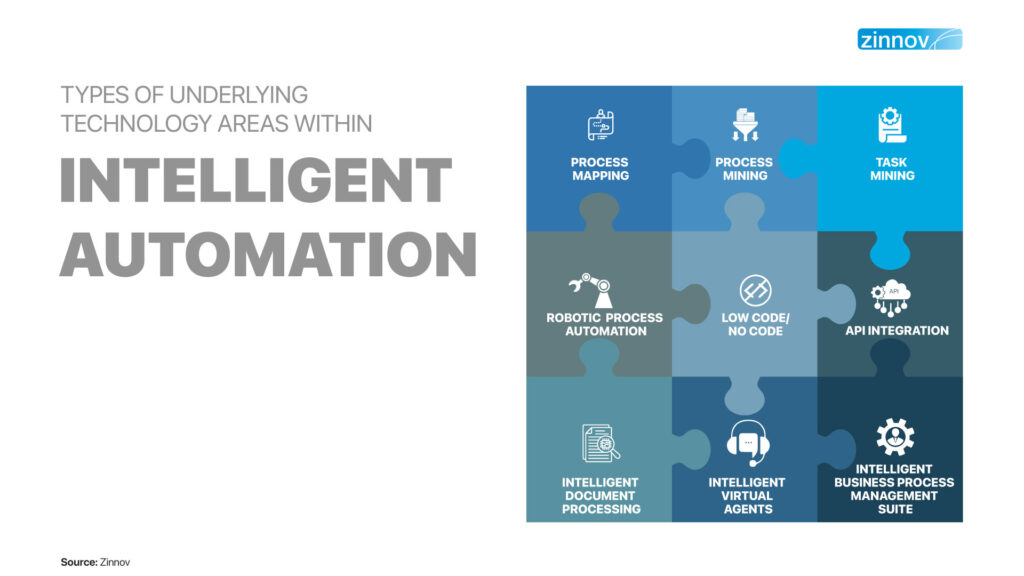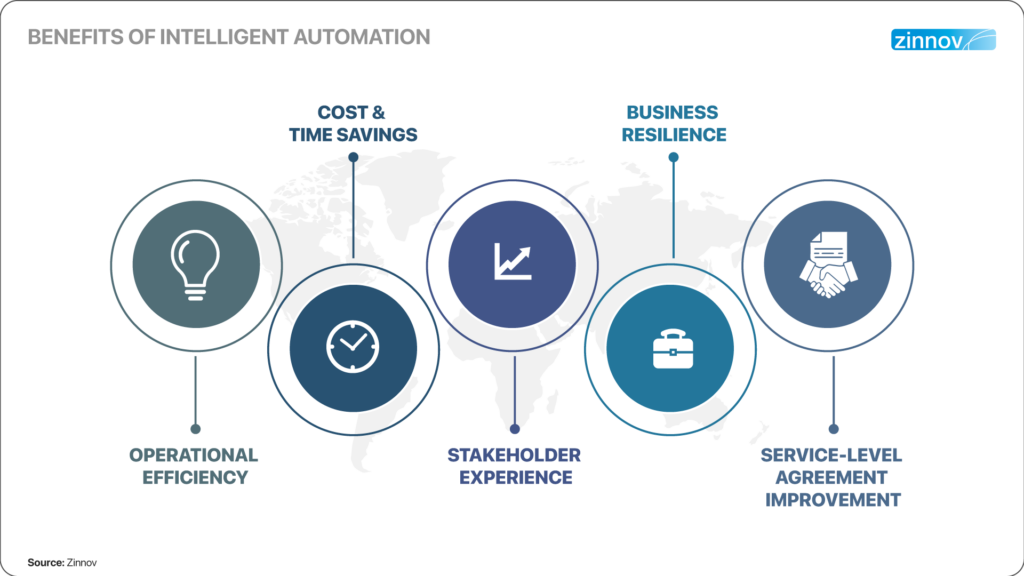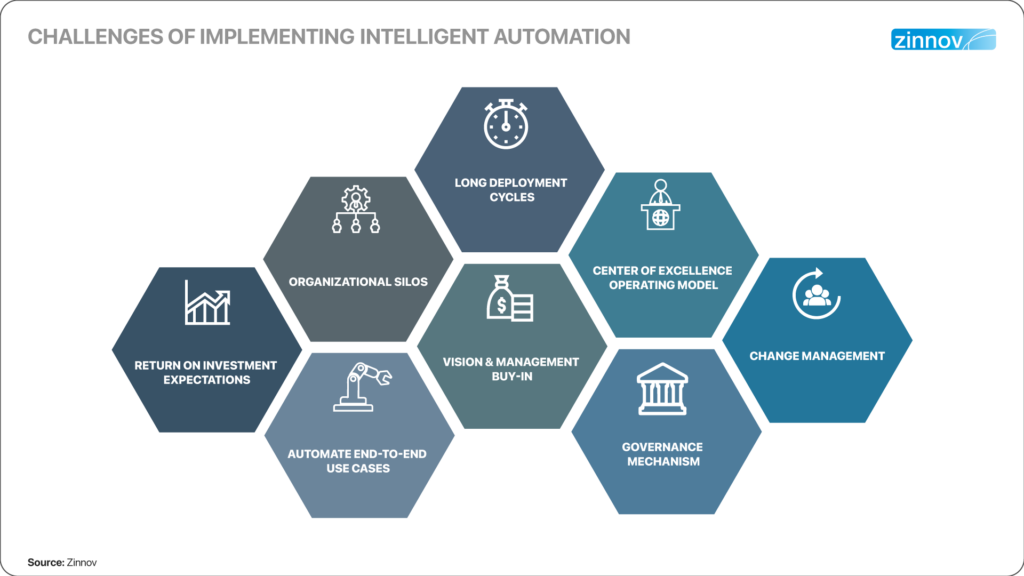|
|
To achieve antifragility and short-circuit digital transformation, enterprises are taking the Intelligent Automation (IA) route, to enable frictionless customer experiences, optimize workflows, and drive business outcomes with a faster turnaround time in the era of unprecedented disruptions. In fact, a recent Zinnov study revealed that 75% of Fortune 250 enterprises have already made significant commitments toward IA. In addition, federal institutions and SMBs (small and medium businesses) alike, are taking keen interest as well, to generate significant value in the next few years. But amidst this strategic race, while many are on track with their transformation strategy, many still have their doubts about what this paradigm is all about.
This article will talk about Intelligent Automation (IA) also called Hyper Intelligent Automation (HIA), its benefits, the challenges organizations face while implementing it, popular use cases, and more.
Intelligent Automation is the convergence of multiple next-gen technologies such as Artificial Intelligence (AI), Robotic Process Automation (RPA), Intelligent Document Processing (IDP), Process Mining, among others that enable enterprises to amplify the ability to automate workflows and unlock greater business outcomes with a faster turnaround time. It is a strategic enterprise game changer that has helped reduce the need for human intervention in existing processes considerably. At present this much sought-after technology is being used to improve internal and external stakeholder experiences, optimize costs, expedite app development time, scale digital transformation, and more.
The following mix of Automation technologies are deeply helping organizations to accelerate business growth at a lightning-fast speed.

Robotic Process Automation is a technology that leverages software bots that can interact with any system or enterprise application, execute rules-based business processes, much similar to how humans can. The major 3 platforms of RPA include players such as UiPath, Blue Prism, and Automation Anywhere. In fact, UiPath went public in April 2021, and Blue Prism was acquired by SS&C Technologies recently in December 2021.
Process Mapping helps understand and optimize existing processes through the graphical representation of complex processes highlighting the inputs, actions, and outputs in a clear, step-by-step detailed map of the process. This entails building a detailed Process Definition Document (PDD) which can help improve business processes and accelerate capabilities. For example, Promapp is a popular process mapping tool that was acquired by Nintex in 2018, and similarly, StepShot was another process mapping and documentation tool acquired by UiPath back in 2019.
Process Mining involves the methodology of leveraging the event logs of enterprise applications like ERP (Enterprise Resource Planning), CRM (Customer Relationship Management) etc., in order to identify inefficiencies and bottlenecks in the existing processes by following the digital trail of the data. Celonis is the industry leader and category creator for Process Mining, and other prominent vendors include Minit, TimelinePI (acquired by Abbyy), myInvenio (acquired by IBM), Signavio (acquired by SAP), to name a few.
Task Mining gives enterprises a deeper view of how their processes run and the inefficiencies. It leverages Optical Character Recognition (OCR), Natural Language Processing (NLP), and ML algorithms to capture/record the user clicks and actual actions performed on a machine to complete a particular task. This is then leveraged to identify the bottlenecks in the sub-processes (or tasks) and incorporate Automation. Players such as Kryon Systems and NICE systems were among the initial tools to build task mining capabilities, and later on, specialist players such as FortressIQ were also incepted.
iBMPS provides greater intelligence to existing business process management solutions, develops dynamic workflow experiences with a Cloud-based platform and Low Code tools. It combines advanced technologies like AI/ML, LC/NC, etc. to rethink workflow capabilities and address the evolving enterprise concerns, in the digital/hybrid working environment.
Low Code/No Code is rapidly transforming the scope of Automation and helping build applications using simple drag and drop, graphical interfaces with minimal (or less) hand coding. LC tools are directed towards the professional (or Pro Code) developers to help them build mission-critical enterprise apps which can be medium to high complexity, almost 4-5 times faster compared to hand-coding. However, LC tools might still require some level of hand-coding apart from the graphical interface. Appian, Pega, Outsystems, Nintex are all popular examples of LC platforms. In addition, NC tools are directed towards building very simple, low complexity apps with no hand-coding. These are typically directed towards business users (or citizen developers) with minimal coding knowledge. Google AppSheet, Unqork, Quickbase, Airtable, etc. are prominent NC platforms, among others. Interestingly, there is a growing convergence happening between LC and NC players – with shifting focus towards NC and vice versa. For instance, Nintex started off as a No Code vendor, working on extremely simple workflow automations aligned to MS Office and Sharepoint workflows. Over the past few years, they have already pivoted towards Low Code and are now handling more medium to high complexity use cases aligned to Sales Ops, and more.
IDP is a data capture solution. It processes semi-structured and unstructured data with intelligence and automates document processing. It is comprised of various steps such as Data Collection, Data Pre-processing, Data Classification, Data Extraction, Data Validation, Data Integration, and Data Analytics. It is helping improve data-driven customer experience in areas like medical claims, loan processing, and more. Kofax, Abbyy, WorkFusion, UiPath Document Understanding, AA IQBot are a few popular examples of IDP platforms.
API enables applications to easily integrate with enterprise applications and backend systems. It helps improve and simplify processes for the end user and enhances productivity. For instance, MuleSoft, Dell Boomi are some popular examples. In fact, UiPath also acquired an API management player Cloud Elements earlier in 2021.
Intelligent Virtual Agents are conversational bots integrated with Cognitive Process Automation and Natural Language Processing capabilities to assist humans in a variety of tasks such as IT support, Finance, and HR. They can also recognize faces, identify similar patterns, and can ask multiple questions to get more context. Amelia, Jacada, Genesys, etc. are a few popular examples.
Incorporating IA helps enhance operations, saves time, costs, improves experiences, accelerates resiliency, and automate document intensive processes.

Since Intelligent Automation enables the Automation of complex processes, and reduces the need for manual intervention and oversight, it highly improves operational efficiency with reduced scope for errors. Cleveland Clinic is one of the best examples where Automation accelerated internal efficiency for patient verification, registration, and administration for COVID emergency requirements. It was able to administer vaccinations to over 150K+ patients in just a span of 2 months, which was a 90% faster rollout.
Organizations retain quite a bit of organizational debt in the form of data storage, security, and more. Thus, automating tasks, processes, across cross-functional areas allows organizations to minimalize their debt and monetize at a greater speed. Full-time equivalent requirements are reduced for daily workflows. It optimizes time, costs, energy and improves productivity by a major scale. Prudential Financials were able to save more than half a million dollars annually on their Automation efforts across use cases such as Premium Calculation, Facilities &Administrative (F&A) costs, Channel Integration, and Remittance Processing, among other things.
Intelligent Automation improves employee and customer experience, and helps meet their needs better, with a faster turnaround time in a more accurate manner. A great example is the American International Group, where Automation was implemented across Customer Service, Operations Support, and F&A. In fact, they were able to achieve a 2x increase in their customer satisfaction (CSAT) scores for processes under customer request management and routing.
Organizations have placed their bet on creating antifragile business solutions that help support a hybrid/remote working scenario. Intelligent Automation helps with optimizing workflows, improving them, deploying new solutions, and is a critical formula for business resilience. For instance, Walmart implemented automation for Operations Support, Warehousing, Supply Chain Management, and F&A and was able to achieve ~95% error reduction in their processes.
Since Intelligent Automation automates document-intensive processes, creating, processing, and managing service-level agreements has improved. For example, Standard Bank was able to automate customer onboarding processes, with a 60% reduction in account opening time.

Many implementers may be over-enthusiastic about Automation and try to start their journey without a futuristic roadmap in place. It’s important to have a clear goal defined on why Automation is being leveraged, which business units (BUs) will it be incorporated in, and how will it align with the enterprise goals. We believe the best practice is to start small, with a POC/Pilot, and then try to find answers attuned to the broader Automation strategy.
Most enterprises rely solely on their IT teams for implementation. But Automation initiatives need to be owned by teams dealing with the business side as well, to provide sufficient knowledge about the underlying processes and generate feedback on improving Automation, if any. Also, the lack of a proper operating structure where the roles and responsibilities are unclear for team members, gives birth to technical and functional ambiguity, increasing the development and deployment cycles. Typically setting up a Center Of Excellence helps in this regard.
A critical boon of Automation is great cost savings and beyond this comes revenue generation, risk mitigation, and error reduction. Enterprises often have trouble tracking these metrics. Thus, it’s imperative for more enterprises to define metrics that can inculcate quantitative factors while sustaining qualitative benefits, such as employee satisfaction, CSAT, Net Promoter Score, etc. into the ROI equation.
Different stakeholders within different BUs may run their own Automation team, which might lead to a duplication of efforts, as identical processes may have already been automated in other parts of the organization. In a siloed approach there is reduced transparency in terms of the best practices, ideation, or implementation. Additionally, a disconnect with the IT teams can surface, which might cause architecture, infrastructure, and security issues. Hence, a clear governance structure (central, decentral, or federated) should be followed and communicated across the enterprise.
It’s highly unlikely for end-to-end processes to be automated with a single technology. Instead, a step-by-step approach can garner greater benefits. Thus, it’s important to divide components and then redesign individual tasks with the vast orchestration of technologies within IA. This makes implementation simple and faster.
With more employees considering Automation to be a roadblock to their jobs — employee resistance has become a major concern in the smooth flow of Automation implementation. Additionally, the majority of enterprises think of change management as an afterthought or reaction to certain situations, but it should ideally be a proactive measure. Making reactionary decisions leads to limited scaling of Automation programs and delays implementation. To accelerate transformation, employees should be educated on what Automation can and cannot do, how it will be an enabler rather than a replacer, and how it can support them in their tasks, and improve existing skills.
Traditional Automation (also known as Robotic Process Automation, or RPA) is a non-invasive automation technology which is used to emulate human actions for mundane, repetitive, and predictable tasks through orchestration of UI interactions. For instance, a software bot keeps the capability to perform certain tasks like opening applications, keyboard shortcuts, navigating systems, data entry, identifying and extract data, and performing a wide range of defined actions.
As mentioned before, IA is the confluence of Traditional Automation & AI to automate more complex use cases. It is an integral extension of Automation that combine multiple advanced technologies and focuses more on the sophistication of business processes (invent, analyze, automate, design, quantify, monitor, reassess).
However, the aim for both technologies is to allow processes to be completed faster, more efficiently, and with higher accuracy. And on an enterprise level improve productivity, lower costs, and risk factors.
Intelligent Automation has proven to be a strategic enterprise gamechanger helping meet business goals at a rapid pace, optimizing costs, time, improving stakeholder experiences, and implementing a more resilient approach toward processes. The space is poised to gain more traction in the coming months and years, with organizations globally hopping onto the IA bandwagon. And while a few still play catch up, strategic measures need to be taken at the earliest to accelerate enterprise-wide transformation, increase net promoter score, and drive business outcomes end-to-end.
Low Code/No Code is allowing low skill developers and non-technical individuals to create software and other tools with a reduced turnaround time. But LC/NC won’t erase the need for traditional coders. DevOps still hold high weightage, even if LC solutions may have a majority share of the market in the coming years.
Low Code Automation is a means of automating business processes through minimalistic coding (interface with drag-and-drop of existing backend code) by leveraging LC/NC platforms, making it easier for even non-technical business users to get hands-on with Automation projects, and hence decreasing dependency on developers.
Robotic Process Automation (RPA) refers to software that can be easily programmed to do basic, repetitive tasks across applications. It creates and deploys a software robot with the ability to launch and operate other software. These robots replicate human intelligence and can cover multiple back-office tasks like identifying and extracting data, performing a wide range of defined actions like document processing, customer connects, and more.
Process Discovery can be defined as a set of tools and techniques that are used to map and analyze the processes of an organization. It reduces the manual effort needed for large-scale process identification and maps the possible process variations and exceptions. These tools and techniques can be automated, including the use of business intelligence (BI) and business analytics (BA).
Process Mining analyzes event logs of enterprise applications (such as SAP, Oracle, etc.) to gauge processes that need optimization (and Automation). Task Mining is an Automation discovery approach that analyzes an employee’s work while they perform it, discovers patterns in the way the tasks are carried out, and identifies the tasks that can be automated.